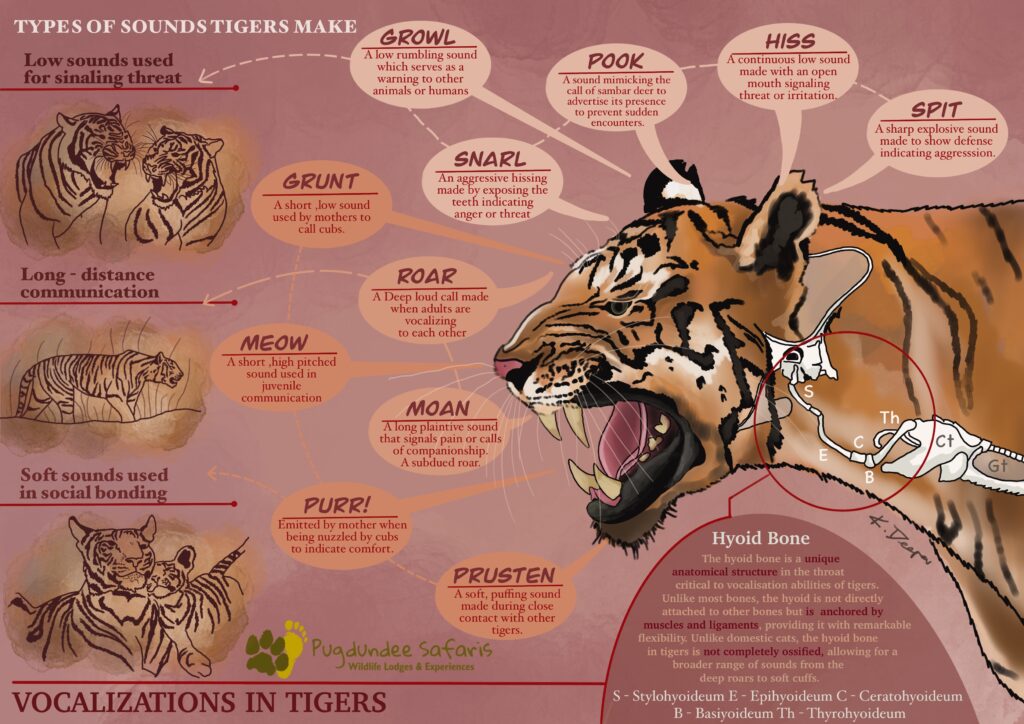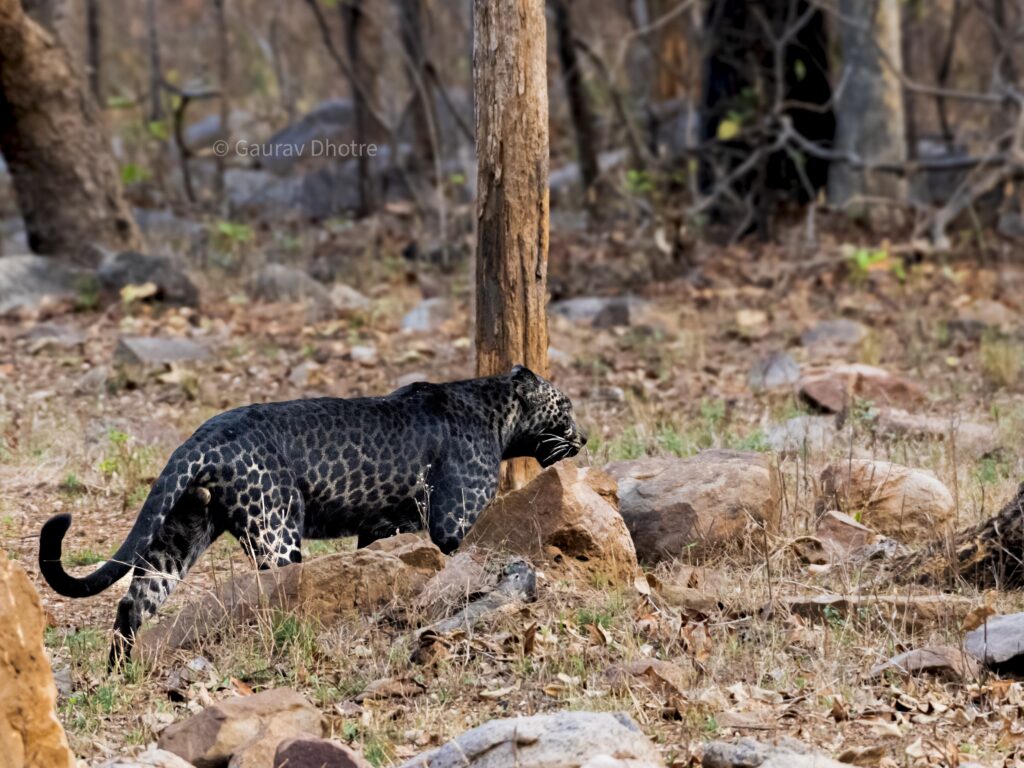In the dense forests and open grasslands where tigers reign supreme, their communication is as powerful as their presence. Through a complex array of vocalizations, these magnificent creatures convey everything from territorial warnings to affectionate greetings. Each sound—whether a thunderous roar or a soft chuff—serves a purpose in their daily lives, helping them navigate their environment, interact with other tigers, and assert their dominance as apex predators.
This blog takes you deep into the world of tiger communication, exploring the anatomy, significance, and diversity of the sounds that define these majestic animals.
VOCALIZATIONS & ACOUSTIC COMMUNICATION IN TIGERS

In the dense jungles and vast landscapes where tigers roam, their majestic presence is often heralded by their powerful and diverse vocalizations. These vocalizations are not just random sounds but are critical components of both inter-specific and intra-specific communication. Understanding these acoustic signals provides deeper insights into tiger behaviour, social structure, and interactions with the environment.
HYOID BONE: THE MAJOR VOCAL ORGAN
Central to the vocal prowess of tigers is the hyoid bone. Unlike domestic cats, the hyoid bone in tigers is not completely ossified, allowing for a broader range of sounds. This flexible structure, along with specialized vocal cords, enables tigers to produce their iconic roars and other distinctive calls that resonate through their territories.
The hyoid bone is a unique anatomical structure in the throat, critical to the vocalization abilities of tigers. Unlike most bones, the hyoid is not directly attached to other bones but is anchored by muscles and ligaments, providing it with remarkable flexibility. This partial ossification in tigers allows greater movement of the larynx and vocal cords, enabling the production of a wide range of sounds, from deep roars to soft chuffs.
The hyoid serves as an anchor point for numerous muscles involved in the movement of the tongue, floor of the mouth, and larynx, which are essential for swallowing, breathing, and vocalizing. This flexibility is fundamental for the precise control of the vocal apparatus, influencing the tension and length of the vocal cords, and is vital for their extensive vocal range necessary for communication and survival in the wild.
Types Of Tiger Sounds and Their Meanings
Tigers use a rich repertoire of sounds to communicate. Each sound has a specific purpose and context, contributing to the complex social and territorial dynamics of these apex predators. Drawing from scientific literature, we can categorize these vocalizations as follows:

1. Roar
Description: A loud, deep and powerful call.
Context: Occurs when adults are vocalizing to each other, advertising, or when irritated. Often heard during the mating season or when a mother is beckoning her cubs.
Function: Long-distance communication to establish territory, attract mates, and deter rivals. Can also signal sexual receptivity.
2. Prusten (Chuff)
Description: A soft, puffing sound is made through the nostrils while keeping the mouth closed.
Context: Used during close contact with other tigers or as a friendly greeting.
Function: Indicates a non-threatening demeanor and fosters social bonds.
3. Growl
Description: A low, rumbling sound.
Context: Deep rolling growl denotes aggressive motivation or readiness to attack. Often occurs in close encounters or during mating.
Function: Serves as a warning to other animals or humans.
4. Snarl

Description: An aggressive sound made by exposing the teeth and producing a hissing, growling noise.
Context: Occurs during direct confrontations, such as disputes over food or territory.
Function: Indicates anger or threat, serving as a deterrent.
5. Grunt
Description: A short, low sound.
Context: Used by mothers to call cubs or in various social interactions.
Function: Part of social communication.
6. Moan
Description: A long, plaintive sound.
Context: Subdued roar that occurs when cub approaches mother’s kill or during peak mating season. Can be heard over 400 meters away.
Function: Signals distress, pain, or calls for companionship. Also used for long-distance advertisement.
. 7. Meow
Description: A short, high-pitched sound.
Context: Emitted by unhappy cubs or courting adult tigers.
Function: Used in juvenile communication or when expressing a need.

8. Spit
Description: A sharp, explosive sound.
Context: Occurs in close-range encounters.
Function: Defensive sound indicating immediate aggression.
9. Hiss
Description: A continuous, low sound made with an open mouth.
Context: Agonistic close-range encounters.
Function: Signals a threat or extreme irritation.
10. Pook
Description: A sound mimicking the call of the sambar deer.
Context: Cross between a hoot and deep bark.
Function: Advertises the tiger’s presence and prevents sudden encounters.
11. Purr
Description: Emitted by mother when being nuzzled by cubs.
Context: Associated with nurturing behaviour.
Function: Indicates comfort and affection.
ACOUSTIC COMMUNICATION: INTER-SPECIFIC AND INTRA-SPECIFIC
Inter-Specific Communication:
Tigers communicate with other species using sounds primarily to assert dominance and avoid unnecessary confrontations. Roars and growls can ward off potential threats or competitors, ensuring the tiger maintains its status as the apex predator.
Intra-Specific Communication:
Within their species, tigers use vocalizations to maintain social bonds, establish territories, and coordinate breeding activities. Prusten, chuffs, and meows are crucial in fostering connections between mothers and cubs, as well as between potential mates.
CONCLUSION
The vocalizations of tigers are more than just sounds; they are a vital part of their survival toolkit. From the resonant roars that echo through the jungle to the gentle chuffs exchanged in close quarters, each sound plays a significant role in the complex tapestry of tiger behaviour. Understanding these vocalizations not only enhances our appreciation of these majestic creatures but also aids in their conservation, ensuring that the symphony of the jungle continues to be heard for generations to come.

REFERENCES
Mills, D. (2004). Tiger Communication and Behavior.
Schaller, G.B. (1967). The Deer and the Tiger: A Study of Wildlife in India.
Sunquist, M., & Sunquist, F. (2002). Wild Cats of the World.
Thapar, V. (2004). Tigers: The Secret Life of Tigers.
Walsh, P. (2004). Vocalizations and Acoustic Communication in Tigers
SUPPORTING INFORMATION
Among wild cats, only a few species can roar, notably the big cats in the genus Panthera, which includes lions, tigers, leopards, and jaguars. This capability is largely attributed to a specialized structure in their vocal apparatus called the hyoid bone, which in these species is partially ossified, allowing for greater flexibility and a larger vocal fold. This adaptation enables them to produce deep, resonant roars that can travel long distances. In contrast, other wild cats such as cheetahs, cougars, and smaller cats cannot roar due to their completely ossified hyoid bones, which limit the range and depth of sounds they can produce, confining them to purrs, growls, and other less powerful vocalizations.
The Hyoid Bone: Anatomy and Physiology
The hyoid bone is a unique anatomical structure found in the throat, playing a pivotal role in the vocalization abilities of various animals, including tigers. Unlike most bones in the body, the hyoid is not directly attached to other bones but is anchored by muscles and ligaments, providing it with remarkable flexibility.
Anatomy of the Hyoid Bone
Structure: The hyoid bone is shaped like a horseshoe and consists of a central body with two pairs of horn-like projections called the greater and lesser cornua.
Position: It is located in the anterior neck region, situated between the base of the tongue and the larynx (voice box).
Components
Body: The central part of the hyoid, which serves as the attachment site for muscles of the tongue and floor of the mouth.
Greater Cornua: Extending posteriorly from the body, these projections provide attachment points for muscles connected to the larynx and pharynx.
Lesser Cornua: Smaller projections that extend upwards from the junction of the body and greater cornua, supporting the stylohyoid ligaments.

Hyoid apparatus, larynx and cranial part of the trachea in the tiger. T, Tympanohyoideum; S, Stylohyoideum; E, Epihyoideum; C, Ceratohyoideum; B, Basiyoideum; Th, Thyrohyoideum; Ct, Cartilago thyroidea; Gt, Glandula thyroidea.
Ref- https://doi.org/10.1046%2Fj.1469-7580.2002.00088.x
Physiology of the Hyoid Bone
Support for Vocalization: In tigers, the partial ossification of the hyoid bone contributes significantly to their ability to produce a wide range of vocalizations. This flexibility allows for greater movement of the larynx and vocal cords, facilitating the production of both low-frequency roars and higher-pitched sounds.
Muscle Attachment: The hyoid serves as an anchor point for numerous muscles involved in the movement of the tongue, floor of the mouth, and larynx. These muscles are crucial for swallowing, breathing, and vocalizing.
Flexibility and Movement: The lack of direct bone-to-bone attachment provides the hyoid with a unique degree of mobility, enabling the fine adjustments needed for precise control of the vocal apparatus.
Vocal Cord Vibration: The hyoid bone’s position and flexibility allow it to influence the tension and length of the vocal cords, which are essential for sound production.
Written by Shashank Arya, Naturalist at Pugdundee Safaris




